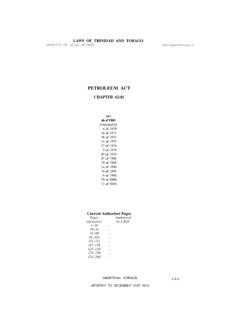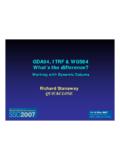Transcription of Petroleum Geology - Power. Prosperity. Progress
1 T r i n i d a d & T o b a g oThe Petroleum of Trinidad has been generated by prolific Upper Cretaceous source rocks, time equivalent to the La Luna and Querecual formations in Columbia and Venezuela. These source rocks were then overlain by a thick succession of Paleogene deep water sediments (shales and deep water sandstones) and shallow marine siliciclastic reservoir rocks. The transpression due to the influence of the Caribbean plate created several sub-basins across the Trinidad area; each hav-ing distinctive Petroleum systems. The hydrocarbon basins in Trinidad are:Southern BasinThis intensely deformed basin has been the site of Petroleum exploration since 1857.
2 Several oil fields have been developed since that time. The main production comes from Miocene and Pliocene clastic deep water and paralic reservoirs, whose hydrocarbons are trapped in detached overthrust and strike-slip related structural traps. The total production from this basin exceeds billion barrels of BasinThe Columbus Basin is a prolific hydrocarbon basin with more than 1 billion barrels of oil pro-duced, and natural gas resources exceeding 25 trillion cubic feet. The basin is a detached exten-sional basin in a transpressional foreland setting.
3 Giant oil fields have been discovered since 1968 but today s major production comes from several gas and condensate fields which feed Trinidad s bourgeoning downstream gas industries. The basin was very rapidly filled with clastic sediments in the Pilocene and Pliestocene. As a result, much of the deep potential of the Columbus Basin shelf remains untested. The continential slope and ultradeep areas of the Columbus Basin are also areas with great untapped Basin and Gulf of Paria Pull-apart BasinThe Caroni Basin is a cenozoic basin bounded to the north by the El Pilar fault zone and the North-ern Range fold-thrust belt and to the south by the Central Range fold-thrust belt.
4 Its stratigraphy features a shallowing section from the Miocene which overlies Palaeocene and Lower Cretaceous deep water sediments. The Gulf of Paria is the western offshore extension of the Caroni basin, However its deformation is now extensional due to the right-stepping of the dextral El Pilar fault to the dextral Warm Springs fault. The Los Bajos fault separates the Gulf of Paria from the Southern basin sediments. Natural gas has been discovered in the onshore Caroni basin while in the Gulf of Paria, both oil and gas have been GeologyT r i n i d a d & T o b a g oCarupano BasinThe Carupano basin is a fore-arc basin composed of several cenozoic clastic sub-basins and in-tervening highs above a basement of Cretaceous and older rocks.
5 Several giant natural gas fields, including Dragon, Patao, El Caribe, Hibiscus, Chaconia, and Poinsetta have been discovered within the Carupano basin. Central Range/Darrien RidgeThis province is a southwest-northeast trending transpressional fold belt created by the oblique collision of the Caribbean plate and the northern margin of South America since the Middle Miocene. The Central Range refers to the onshore area while the eastern offshore extension of this province is called the Darrien Ridge. The discovery of the prolific Angostura oil and gas field in 1999 revitalised exploration interest over these domains, with the search for hydrocarbons in related geological provinces across Trinidad and Tobago.
6 (FTB refers to fold-thrust belt)











